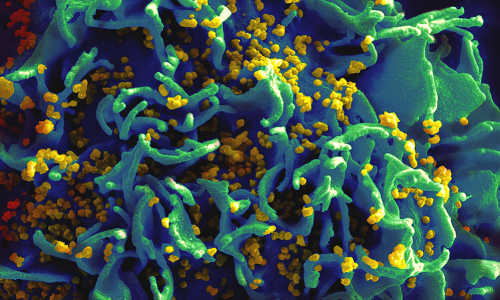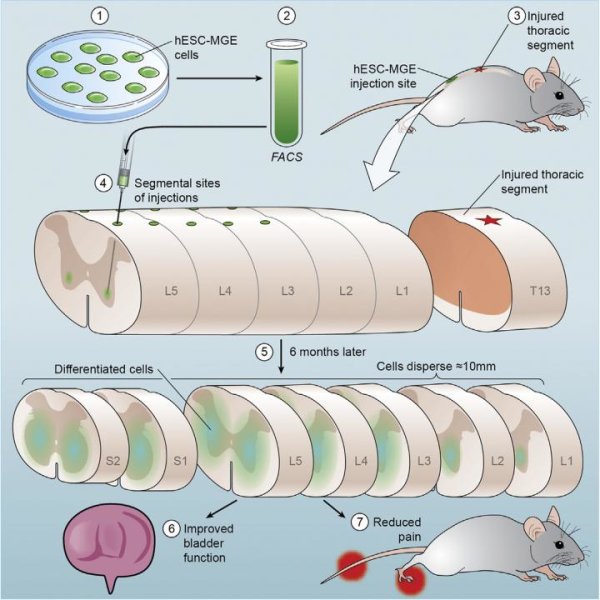Using modified human stem cells, a team of UC Davis scientists has developed an improved gene therapy strategy that in animal models shows promise as a functional cure for the human immunodeficiency virus (HIV) that causes AIDS. The achievement, which involves an improved technique to purify populations of HIV-resistant stem cells, opens the door for human clinical trials that were recently approved by the U.S. Food and Drug Administration.
This scanning electron micrograph shows HIV particles infecting a human T cell. Photo Credit: National Institutes of Health
“We have devised a gene therapy strategy to generate an HIV-resistant immune system in patients,” said Joseph Anderson, principal investigator of the study and assistant professor of internal medicine. “We are now poised to evaluate the effectiveness of this therapy in human clinical trials.”
Anderson and his colleagues modified human stem cells with genes that resist HIV infection and then transplanted a near-purified population of these cells into immunodeficient mice. The mice subsequently resisted HIV infection, maintaining signs of a healthy immune system.
The findings are now online in a paper titled “Safety and efficacy of a tCD25 pre-selective combination anti-HIV lentiviral vector in human hematopoietic stem and progenitor cells,” and will be published in the journal Stem Cells.
Using a viral vector, the researchers inserted three different genes that confer HIV resistance into the genome of human hematopoietic stem cells – cells destined to develop into immune cells in the body. The vector also contains a gene which tags the surface of the HIV-resistant stem cells. This allows the gene-modified stem cells to be purified so that only the ones resistant to HIV infection are transplanted. The stem cells were then delivered into the animal models, with the genetically engineered human stem cells generating an HIV-resistant immune system in the mice.
The three HIV-resistant genes act on different aspects of HIV infection – one prevents HIV from exposing its genetic material when inside a human cell; another prevents HIV from attaching to target cells; and the third eliminates the function of a viral protein critical for HIV gene expression. In combination, the genes protect against different HIV strains and provide defense against HIV as it mutates.
After exposure to HIV infection, the mice given the bioengineered cells avoided two important hallmarks of HIV infection: a drop in human CD4+ cell levels and a rise in HIV virus in the blood. CD4+ is a glycoprotein found on the surface of white blood cells, which are an important part of the normal immune system. CD4+ cells in patients with HIV infection are carefully monitored by physicians so that therapies can be adjusted to keep them at normal level: If levels are too low, patients become susceptible to opportunistic infections characteristic of AIDS. In the experiments, mice that received the genetically engineered stem cells and infected with two different strains of HIV were still able to maintain normal CD4+ levels. The mice also showed no evidence of HIV virus in their blood.
Although other HIV investigators had previously bioengineered stem cells to be resistant to HIV and conducted clinical trials in human patients, efforts were stymied by technical problems in developing a pure population of the modified cells to be transplanted into patients. During the process of genetic engineering, a significant percentage of stem cells remain unmodified, leading to poor resistance when the entire population of modified cells is transplanted into humans or animal models. In the current investigation, the UC Davis team introduced a “handle” onto the surface of the bioengineered cells so that the cells could be recognized and selected. This development achieved a population of HIV-resistant stem cells that was greater than 94 percent pure.
“Developing a technique to purify the population of HIV-resistant stem cells is the most important breakthrough of this research,” said Anderson, whose laboratory is based at the UC Davis Institute for Regenerative Cures. “We now have a strategy that shows great promise for offering a functional cure for the disease.”
A “functional” cure of HIV means that the virus is no longer detectable in the blood and the patient has no signs or symptoms of the disease. Viruses may still be hiding in cells in the body, but it is believed they are no longer causing harm. This line of research is inspired by the so-called “Berlin patient,” a man who was HIV-positive and developed acute myeloid leukemia, requiring a stem cell transplant involving complete replacement of his immune system. The donor supplying the stem cells had a mutation known to resist HIV infection. Since undergoing the transplant, the Berlin patient has been free of disease despite being off antiretroviral therapy.
The new cellular therapy method was also found to be safe: at six months, no signs of toxicity or tumor formation were found, and the animal models provided with the genetically modified cells appeared to generate a normal immune system. For the upcoming human clinical trials, the stem cells will be autologous – taken from the bone marrow of a patient’s own body, which avoids the common transplantation risk of rejection.
Story Source:
The above story is based on materials provided by UC Davis Health System.





